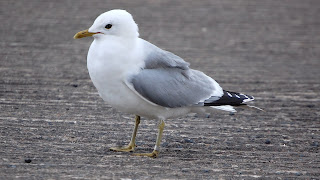If you've never seen a Black-headed Gull colony in action, you're spoilt for choice in Northern Ireland. Three colonies which you could visit very easily (all in the same day if you wanted), are the Cockle Island Seabird Centre in Groomsport which as around 400 nesting pairs, the RSPB's Belfast Harbour Reserve where there are around 100 pairs nesting on the two tern islands in the lagoon, or WWT Castle Espie, where Kerry Mackie has told me there are currently around 370 pairs, although many still appear to be incubating.
If you choose to visit Belfast Harbour, amongst the Black-headed Gulls there is a slightly odd looking bird and this is actually a Black-headed Gull x Mediterranean Gull hybrid which is breeding with a regular Black-headed Gull.
 |
| Photo by Ronald Surgenor |
 |
| Photo by Ronald Surgenor |
 |
| Photo by Ronald Surgenor |
 |
| Photo by Ronald Surgenor |
Exciting news, well I think so at least(!), is that there are around 50 pairs nesting on Copeland Bird Observatory, the first time they've done so, although there have always been colonies on Mew Island and Big Copeland. Shane Wolsey reported that the first chicks were just emerging last weekend, so hopefully, there will be plenty of young to ring when I visit the Observatory at the end of next week.
The other piece of big news is that I've also been granted permission by RSPB to ring pulli Black-headed Gulls on Blue Circle Island in Larne Lough.
Blue Circle is a man-made island which is home to a colony of around 2000 pairs of Black-headed Gull, so it's fantastic to get to include it in the study. As well as Black-heads, other species which nest on the island included Common Gull, Sandwich Tern, Common Tern, Red-breasted Merganser and Black Guillemots. The site also supports a small colony of Mediterranean Gulls (6 pairs in 2012), and Northern Ireland's only breeding pair of Roseate Tern, although birds were also seen hanging around Mew Island and Cockle Island in Groomsport last year.
Here is a short video clip which I took during a visit to Blue Circle Island last June with Matthew Tickner, RSPB NI Reserves' Ecologist, when we visited to monitor the Common Tern nests:
RSPB NI have also supported the project by agreeing to purchase a batch of rings, which is very much appreciated and gratefully received!






+Kevin+Mawhinney.JPG)




